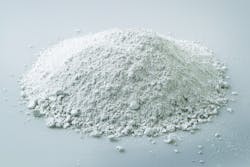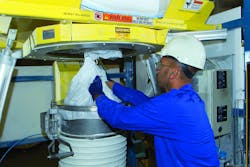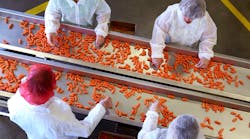Trinseo Netherlands BV employs 80 people in running eight compounding lines in a nearly 54,000-square-foot plant. It recently installed two bulk-bag discharging systems with integral flexible screw conveyors.
One system unloads and conveys talc used to improve the mechanical properties of polypropylene compounds; the other unloads and transports an impact modifier in polycarbonate/ABS formulations. The investment is increasing productivity, worker safety and plant cleanliness.
The bulk bag dischargers replace manual unloading, says Ron Drabbe, senior improvement specialist, Trinseo Netherlands, which was known as Dow Benelux prior to its acquisition in 2009 by private equity.
Operator pulls the bag’s outlet spout through a flow-control valve, which prevents product leakage.
Not so labor-intensive
Each bulk bag weighs more than 1,300 pounds. Unloading a bag previously required three workers, says Drabbe. Two would mechanically hoist a bag above a hopper while a third, working from a platform atop the hopper, connected the bag to a discharge unit and dislodged trapped residue by hand.
Non-free-flowing talc was especially prone to lodging in the corners of the bags.
Besides injury risk, "unloading generated dust, which settled on the plant floor," says Drabbe.
In contrast, each bulk-bag discharger frame includes a cantilevered I-beam with an electric hoist and trolley, allowing a single worker to raise and position a bulk bag above the unit receiving hopper.
According to Drabbe, because the discharger is automatic and dust-free, Trinseo Netherlands can discharge as many bulk bags as needed, both rapidly and safely.
Ease of operation
Bulk bag discharger positions the bag from a cantilevered I-beam with an electric hoist and trolley and cross-shaped bag-lifting frame. The discharger provides complete evacuation of the bag, flow and dust control at the bag spout interface, and PLC control for automatic operation. The flexible screw conveyor transports talc to the blending hopper. (Courtesy Siemens)
A cross-shaped, bag-lifting frame attaches to the straps on each bag corner, and the electric hoist lifts the bag into place on the discharger frame. The operator pulls the bag’s outlet spout through a flow-control valve with elliptically contoured bars that close concentrically around the spout, preventing product leakage.
The clean side of the bag spout attaches to the clean side of the discharger by means of a clamp ring, mounted atop a telescoping tube that maintains constant downward tension on the bag as it empties and elongates, promoting material flow through the bag spout.
Pneumatically actuated flow-promotion devices raise and lower opposite bottom sides of the bag, forming a “V” shape to promote total discharge into the hopper.
The hopper is vented to a dust collector that vacuums displaced air and dust from the sealed system as talc or impact modifier discharge from the bag, improving plant cleanliness, Drabbe says.
Maintained talc quality
As material enters the hopper, a flexible screw conveyor, more than 34 feet long and 4.5 inches in diameter, transports talc or GRC at a 45-degree incline to an inlet hopper for blending with other additives and resins before compounding. The conveyor’s flexible stainless-steel screw has special geometry to handle non-free-flowing materials.
One screw-design benefit is that it conveys talc consistently, regardless of its moisture content.
Drabbe says that the density of conveyed talc often decreases when ambient air reduces its moisture content. "A lower density means more talc volume, reducing the amount that gets added to a formulation and affecting production throughput in a negative way," he explains.
Only one other materials-handling system that he evaluated, a mechanical unit, was unaffected by talc density, but Drabbe says it was unable to handle bulk bags.
A programmable logic controller (PLC) governs discharger and conveyor operation. Limit switches stop the conveyors from running when the hoppers under the dischargers become empty, and proximity sensors stop the conveyors when sufficient material has been transported to the compounding hoppers.
Trinseo Netherlands evaluated a number of pneumatic, vacuum and mechanical materials-handling systems. Drabbe says the Bulk-Out BFC-X Bulk Bag Discharging equipment outperformed them, and Flexicon Europe personnel provided assistance in designing the installations to enhance their operation.
The throughput, dust-free operation and minimal operator involvement of the discharger stations have met expectations. Trinseo Netherlands will likely add a third bulk bag discharging station for talc, Drabbe says.
David Boger is vice president of global business development & marketing, Flexicon Corp.
Flexicon Corp. manufactures bulk-handling equipment and custom-engineered and integrated plant-wide systems, with products that range from individual equipment to automated systems. This equipment sources bulk material from interior and exterior plant locations, and transports, weighs, blends and feeds it to packaging lines, extruders, molding machines, storage vessels, and railcars and trailers.




